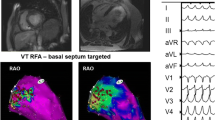Abstract
Although PVCs commonly lead to degraded cine cardiac MRI (CMR), patients with PVCs may have relatively sharp cine images of both normal and ectopic beats (“double beats”) when the rhythm during CMR is ventricular bigeminy, and only one beat of the pair is detected for gating. MRI methods for directly imaging premature ventricular contractions (PVCs) are not yet widely available. Localization of PVC site of origin with images may be helpful in planning ablations. The contraction pattern of the PVCs in bigeminy provides a “natural experiment” for investigating the potential utility of PVC imaging for localization. The purpose of this study was to evaluate the correlation of the visually assessed site of the initial contraction of the ectopic beats with the site of origin found by electroanatomic mapping. Images from 7 of 86 consecutive patients who underwent CMR prior to PVC ablation were found to include clear cine images of bigeminy. The visually apparent site of origin of the ectopic contraction was determined by three experienced, blinded CMR readers and correlated with each other, and with PVC site of origin determined by 3D electroanatomic mapping during catheter ablation. Blinded ascertainment of visually apparent initial contraction pattern for PVC localization was within 2 wall segments of PVC origin by 3D electroanatomic mapping 76% of the time. Our data from patients with PVCs with clear images of the ectopic beats when in bigeminy provide proof-of-concept that CMR ectopic beat contraction patterns analysis may provide a novel method for localizing PVC origin prior to ablation procedures. Direct imaging of PVCs with use of newer cardiac imaging methods, even without the presence of bigeminy, may thus provide valuable data for procedural planning.




Similar content being viewed by others
Data availability
Not applicable.
Code availability
Not applicable.
References
Atkinson DJ, Edelman RR (1991) Cineangiography of the heart in a single breath hold with a segmented turboFLASH sequence. Radiology 178(2):357–360
Feng L et al (2016) XD-GRASP: golden-angle radial MRI with reconstruction of extra motion-state dimensions using compressed sensing. Magn Reson Med 75(2):775–788
Contijoch F et al (2016) Quantification of left ventricular function with premature ventricular complexes reveals variable hemodynamics. Circ Arrhythm Electrophysiol 9(4):e003520
Cerqueira MD et al (2002) Standardized myocardial segmentation and nomenclature for tomographic imaging of the heart A. A statement for healthcare professionals from the Cardiac Imaging Committee of the Council on Clinical Cardiology of the American Heart Association. Circulation 105(4):539–542
Cuculich PS et al (2017) Noninvasive cardiac radiation for ablation of ventricular tachycardia. N Engl J Med 377(24):2325–2336
Graham AJ et al (2020) Evaluation of ECG imaging to map hemodynamically stable and unstable ventricular arrhythmias. Circ Arrhythm Electrophysiol 13(2):e007377
Revah G et al (2016) Cardiovascular magnetic resonance features of mechanical dyssynchrony in patients with left bundle branch block. Int J Cardiovasc Imaging 32(9):1427–1438
Dwivedi A, Axel L (2017) Abnormal motion patterns of the interventricular septum. JACC Cardiovasc Imaging 10(10 Pt B):1281–1284
Funding
No relevant financial support.
Author information
Authors and Affiliations
Contributions
All authors contributed to the study conception and design. Material preparation, data collection and analysis were contributed to by all authors. The first draft of the manuscript was written by LA and all authors commented on previous versions of the manuscript. All authors read and approved the final manuscript.
Corresponding author
Ethics declarations
Conflict of interest
Leon Axel has patents that are indirectly related to this work. Chirag Barbhaiya, has consulting arrangements related to catheter ablation technology with: Biosense Webster, Abbott Medical, and Philips Consulting.
Ethical approval
This study was performed under an IRB-approved retrospective data analysis protocol.
Consent to participate
Not applicable.
Consent for publication
Not applicable.
Additional information
Publisher's Note
Springer Nature remains neutral with regard to jurisdictional claims in published maps and institutional affiliations.
Supplementary Information
Below is the link to the electronic supplementary material.
10554_2022_2707_MOESM1_ESM.m4v
Supplementary file1 (M4V 177 kb) Online Video 1 2-chamber Cine of Patient 6. 2-chamber cine of bigeminy Patient 6, showing premature beat with initial contraction seen in the basal anterior LV wall, followed by synchronous normal beat, as shown in Figure 1.
10554_2022_2707_MOESM2_ESM.m4v
Supplementary file2 (M4V 137 kb) Online Video 2 Basal Short-axis Cine of Patient 6. Basal short-axis cine of bigeminy Patient 6, showing premature beat with initial contraction seen in the basal anterior LV wall, followed by synchronous normal beat, as shown in Figure 2.
10554_2022_2707_MOESM3_ESM.m4v
Supplementary file3 (M4V 104 kb) Online Video 3 3-chamber Cine of Patient 5. 3-chamber cine of bigeminy Patient 6, showing initial synchronous normal beat contraction, followed by premature beat with initial contraction seen in the basal RVOT, as shown in Figure 3.
Rights and permissions
Springer Nature or its licensor holds exclusive rights to this article under a publishing agreement with the author(s) or other rightsholder(s); author self-archiving of the accepted manuscript version of this article is solely governed by the terms of such publishing agreement and applicable law.
About this article
Cite this article
Axel, L., Bhatla, P., Halpern, D. et al. Correlation of MRI premature ventricular contraction activation pattern in bigeminy with electrophysiology study-confirmed site of origin. Int J Cardiovasc Imaging 39, 145–152 (2023). https://doi.org/10.1007/s10554-022-02707-8
Received:
Accepted:
Published:
Issue Date:
DOI: https://doi.org/10.1007/s10554-022-02707-8




